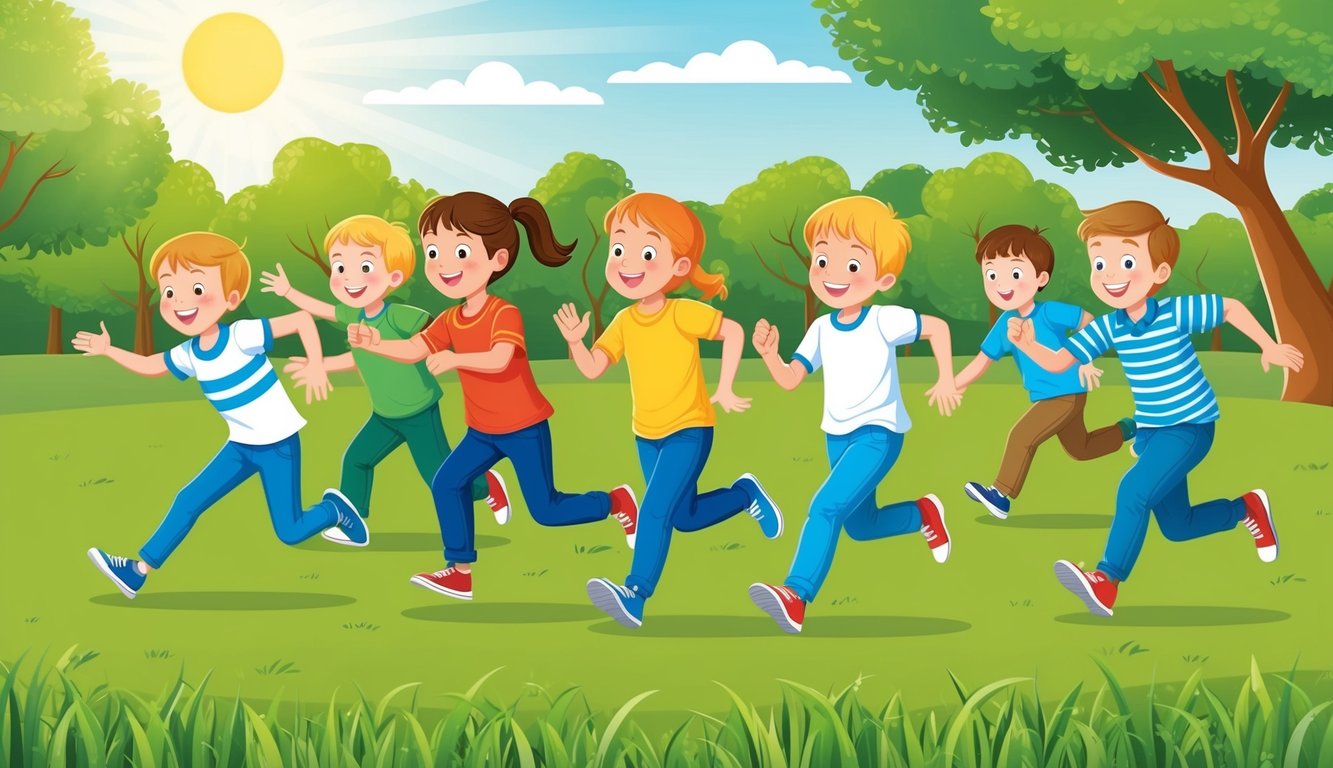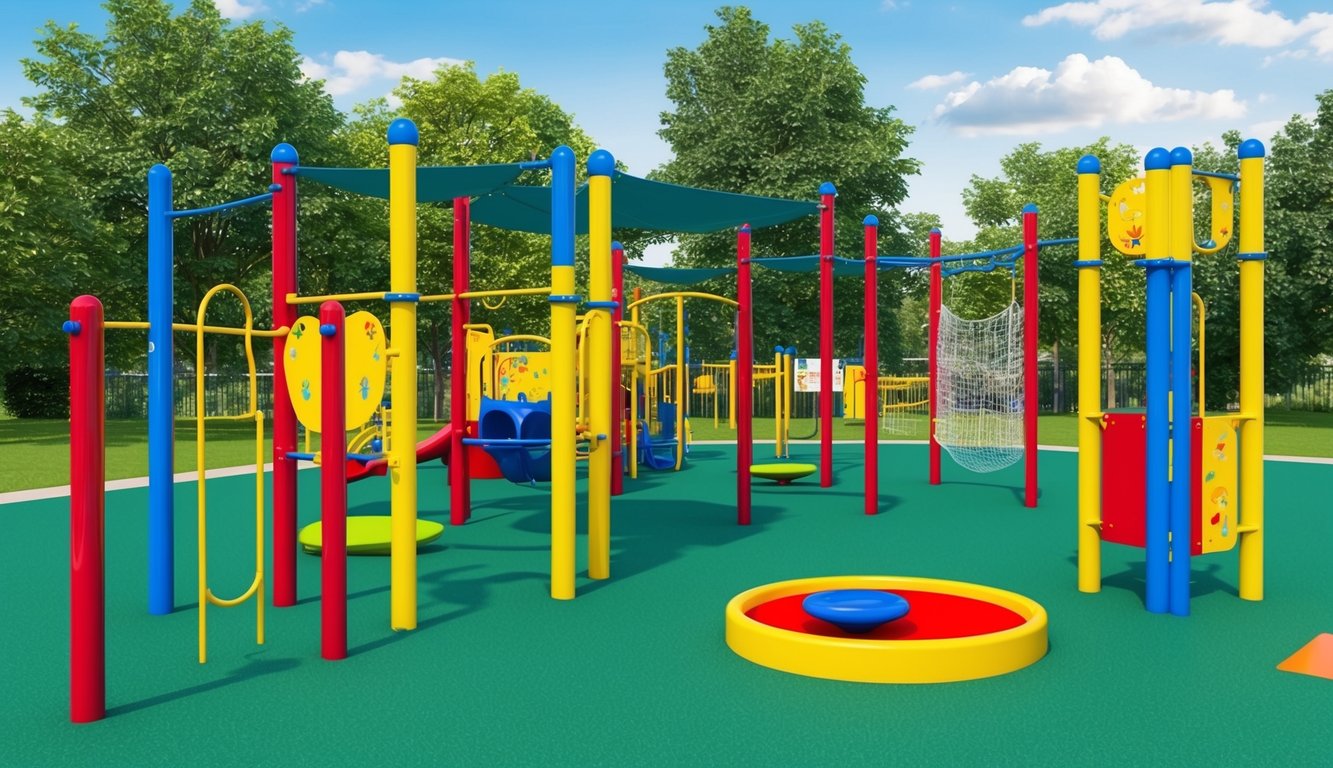Remember the thrill of playing tag as a kid? Well, now you can relive those exciting moments with friends right on your screen! Tag & chase games bring that classic playground fun into the digital world, letting you and your buddies compete in fast-paced matches of skill and strategy.

These local multiplayer games are perfect for gatherings, allowing 2 to 4 players to join in on a single device. You’ll race through various levels, dodging obstacles and using special features like teleporters or jelly platforms to outsmart your opponents.
It’s a great way to bond with friends and family while enjoying some lighthearted competition.
Kids especially love these games, but they’re fun for all ages.
You can choose from different maps, each offering unique challenges and tactical elements.
Whether you’re the chaser or trying to avoid being tagged, you’ll need quick reflexes and clever thinking to come out on top.
So grab your friends, pick a level, and get ready for some tag & chase action!
History and Evolution of Tag

Tag games have been around for centuries, evolving from simple chasing games to more complex variations.
You’ll find that the basic concept has remained largely unchanged, but new twists have kept it fresh and exciting.
Origins of Tag Games
Tag’s exact origins are unclear, but similar chasing games have existed in cultures worldwide for generations.
You might be surprised to learn that ancient Greek and Roman children played versions of tag.
In medieval Europe, tag-like games were popular among both kids and adults.
One theory credits James Haney, a Philly PE teacher, with inventing modern tag in the early 20th century.
He’s said to have introduced variations like freeze tag, adding strategy to the mix.
While this claim is debated, it shows how tag has been shaped by educators and players over time.
Modern Adaptations
You’ve probably noticed tag games have come a long way.
In recent years, tag has even gone pro! World Chase Tag, founded by the Devaux brothers in the UK, turned backyard fun into a competitive sport.
Tag’s also breaking records.
In November 2019, Phoenix, Arizona hosted the world’s largest freeze tag game with 2,172 participants.
That’s a lot of “it”!
New variations keep popping up too.
From zombie tag to laser tag, you’ll find endless ways to play.
Basic Rules of Tag
Tag is a simple yet exciting game that revolves around chasing and touching.
The core rules are straightforward, but variations can add complexity and fun to this classic playground activity.
Role of the Tagger
The tagger, often called “It,” has the primary job of chasing and tagging other players.
You become the tagger by being touched by the previous one.
As “It,” your goal is to tag someone else as quickly as possible.
You’ll need to be fast and strategic, looking for opportunities to catch others off guard.
Tagging usually involves a light touch with your hand.
Once you’ve tagged someone, you should immediately announce it by yelling “Tag!” or “You’re It!” This passes the role to the newly tagged player.
Safe Zones Explained
Safe zones are designated areas where players can’t be tagged.
These spots offer temporary refuge from the tagger.
Common safe zones include:
- “Base”: A specific object like a tree or playground equipment
- Time-limited safe spots: Areas where you can only stay for a short time (e.g., 10 seconds)
- “Free” areas: Zones that are always off-limits to the tagger
Safe zones add strategy to the game.
You’ll need to decide when to risk leaving safety to run around and when to stay put.
Dynamics of Being ‘It’
Being “It” changes the game for you.
Suddenly, everyone else becomes your target.
You’ll need to:
- Chase after other players
- Use quick changes of direction to catch people off guard
- Try to predict where others will run
Remember, you can’t just tag the same person back immediately after they’ve tagged you.
This rule, often called “No tag-backs,” keeps the game moving and prevents it from getting stuck between two players.
As “It,” you might feel a mix of excitement and pressure.
The thrill of the chase is balanced by the desire to pass on the role quickly.
Your strategy might change based on how many players are in the game and the size of the play area.
Popular Variations of Tag

Tag games have evolved into exciting new versions that add thrills and unique challenges.
These variations keep the classic chase format while introducing creative twists to engage players of all ages.
Freeze Tag and Its Appeal
In freeze tag, when you’re tagged, you freeze in place until a teammate unfreezes you.
This adds a fun rescue element to the game.
You have to be quick to unfreeze others while avoiding getting tagged yourself.
It creates an exciting back-and-forth as players are frozen and unfrozen.
Freeze tag works great for large groups.
You can easily join or leave the game as players get tired.
Some fun twists include having multiple taggers or designating “safe zones” where you can’t be frozen.
Exploring Team Tag Dynamics
Team tag splits players into two or more groups competing against each other.
You work together to tag opponents or protect teammates.
Popular versions include Cops and Robbers, where one team tries to catch the other and put them in “jail.”
In British Bulldog, you start with one tagger trying to catch runners as they cross a field.
Caught players join the tagging team, creating an ever-growing group of catchers.
This builds excitement as the teams shift in size.
The Thrills of Zombie Tag
Zombie tag adds a spooky twist to the classic game.
One player starts as a zombie, trying to tag others to turn them into zombies too.
As a human, you must outrun the growing zombie horde.
This version creates rising tension as more players become zombies.
You can add elements like safe zones or items that temporarily stun zombies.
Some variations have the last human survivor become the starting zombie for the next round.
Zombie tag works great for Halloween parties or night games with glow sticks.
It lets you unleash your inner monster while getting plenty of exercise chasing your friends.
Tag Games Around the World
Tag games have evolved into diverse forms across cultures, each with unique rules and traditions.
Two popular variations that have captured imaginations globally are Manhunt and Ringolevio.
Manhunt: A Global Favorite
You’ve probably played Manhunt at some point – it’s a thrilling twist on traditional tag.
In this game, you and your friends split into two teams: hunters and prey.
As a hunter, your goal is to catch all the prey before time runs out.
If you’re prey, you’ll need to stay hidden or outrun the hunters.
Manhunt is played in neighborhoods, parks, and even entire cities.
It’s especially popular at night, adding an extra layer of excitement.
Some variations include:
- Using flashlights to spot prey
- Setting up “safe zones” where prey can’t be tagged
- Allowing caught players to be rescued by teammates
Ringolevio and Its Cultural Significance
Ringolevio is a tag game with roots in New York City street culture.
You might not have heard of it, but it’s been a staple in urban areas for generations.
The game combines elements of tag, hide-and-seek, and capture the flag.
Here’s how you play:
- Split into two teams
- One team hides while the other counts
- Seekers try to catch and “imprison” hiders
- Hiders attempt to free their captured teammates
Ringolevio reflects the gritty nature of city life, teaching kids strategy, teamwork, and street smarts.
It’s more than just a game – it’s a cultural touchstone that’s been immortalized in literature and film about urban childhood.
Tag Equipment and Play Spaces

Tag games require minimal setup but thrive in diverse environments.
The right space and optional equipment can enhance the excitement and challenge of these classic chase games.
From Open Fields to Urban Jungles
You can play tag almost anywhere with enough room to run.
Spacious fields offer freedom of movement and clear sightlines.
Playgrounds add obstacles and climbing elements for more complex chases.
Urban settings like parks or schoolyards provide natural boundaries and hiding spots.
Wooded areas create an immersive experience with trees as cover.
Indoor spaces like gyms work well in bad weather.
You can even adapt tag for smaller areas by modifying rules or movement styles.
Consider safety when choosing a play area.
Look for level ground without tripping hazards.
Establish clear boundaries and designate safe zones where players can catch their breath.
The Role of Equipment in Tag Games
While traditional tag needs no gear, simple items can add variety.
Foam pool noodles extend reach for a safe “tagging” tool.
Colored pinnies or bandanas help identify teams or “it” players.
Cones or chalk mark boundaries and safe zones.
Stopwatches time rounds or measure how long “it” players last.
Soft balls introduce throwing elements to games like dodge tag.
For glow-in-the-dark night games, use LED armbands or glow sticks.
Blindfolds transform tag into a sensory challenge.
Props like hula hoops create mobile safe zones you can carry.
Remember, equipment should enhance play, not complicate it.
Keep items soft and lightweight for safety.
With creativity, everyday objects become tag game gear.
Digital and Virtual Tag Games
Tag games have entered the digital realm, bringing classic chase fun to screens big and small.
These virtual versions test your reflexes and strategizing skills in new ways.
Bringing Tag to Desktop and Mobile Platforms
You can now play tag without leaving your seat.
Desktop and mobile platforms offer a variety of tag-inspired games.
On your computer, web browser-based games let you chase or flee from other players in colorful 2D or 3D environments.
Mobile apps take the excitement on the go, with touch controls for dodging and tagging.
Some games add twists like power-ups or obstacles.
You might find yourself teleporting across the map or using special abilities to catch opponents.
These digital versions often support multiplayer modes, so you can play with friends online.
The Importance of Quick Reflexes in Digital Tag
In virtual tag games, your reflexes are put to the test.
You’ll need to react fast to avoid getting tagged or to catch your target.
Many games increase the challenge by speeding up gameplay over time.
Quick thinking is crucial.
You must anticipate your opponents’ moves and plan escape routes.
Some games add pressure with countdown timers or shrinking safe zones.
To excel, practice reading the game environment and responding swiftly to changes.
Digital tag often requires multitasking.
You might need to dodge obstacles while chasing a player or collect power-ups without getting caught.
Sharpening these skills can improve your overall gaming performance.
Novelty Tag Variants

Tag games come in many creative forms beyond the classic version.
Some unique variants add extra challenges or equipment to shake up the traditional chase.
Underappreciated Gems: Sock and Wood Tag
Ever tried playing tag with a twist? In sock tag, you’ve got to remove one of your socks and use it to tag others.
No touching allowed – only sock swipes count!
It’s hilarious to watch players hop around on one sock while wielding the other.
Wood tag takes things up a notch.
You’ll need to carry a small piece of wood while running.
To tag someone, you have to touch them with your wood piece.
But watch out! If you drop it, you become “it” instead.
These games add an extra layer of coordination and silliness to your tag sessions.
Nighttime Excitement with Flashlight Tag
When the sun goes down, the fun doesn’t have to stop.
Flashlight tag brings a thrilling element to nighttime play.
You’ll need a flashlight for each player.
The person who’s “it” tries to catch others by shining their light on them.
Everyone else scurries around in the dark, trying to avoid the beam.
It’s like a game of cat and mouse with an added spooky factor.
For extra challenge, set boundaries in your yard or a local park.
Just make sure the area is safe for running in low light conditions.
Educational Benefits of Tag Games
Tag games offer valuable learning opportunities while kids have fun.
These active play experiences support cognitive growth and physical development in engaging ways.
Cognitive Development Through Play
Tag games enhance problem-solving and decision-making skills.
You must think quickly to avoid being tagged or to tag others.
This fast-paced play sharpens reflexes and improves reaction time.
Strategic thinking comes into play as you plan escape routes or devise ways to catch opponents.
Tag games also boost spatial awareness.
You learn to navigate your environment and judge distances effectively.
Social skills flourish during tag.
You practice teamwork in group variations and learn to follow rules.
These games teach fair play and good sportsmanship too.
Physical Education and Tag
Tag games are excellent for physical fitness.
You get a full-body workout as you run, dodge, and change direction rapidly.
This improves cardiovascular health and builds endurance.
Agility and coordination develop naturally through the quick movements required.
You learn to control your body better as you navigate around obstacles and other players.
Tag helps with balance and core strength too.
The constant starting, stopping, and pivoting engages multiple muscle groups.
It’s a fun way to stay active without feeling like you’re exercising.
These games are adaptable for various skill levels, making them ideal for PE classes.
They require minimal equipment, so you can play almost anywhere.
Tag and Pop Culture
Tag games have left their mark on popular culture, inspiring movies, books, and even professional competitions.
The simple childhood pastime has evolved into thrilling entertainment and sporting events that captivate audiences worldwide.
Tag in Movies and Literature
Remember the last time you saw tag in a movie? It’s probably more recent than you think.
Hollywood has embraced the game’s potential for comedy and action.
The 2018 film “Tag” follows a group of friends who’ve been playing the same game of tag for 30 years.
It’s based on a true story, believe it or not!
In literature, tag often symbolizes the chase or pursuit themes.
You’ll find it in children’s books like “The Gingerbread Man” where the classic line “Run, run as fast as you can!” echoes the excitement of a tag game.
Don’t forget about variations like “Cops and Robbers” – a staple in crime dramas and action flicks.
This tag-inspired game adds a layer of strategy and role-playing that translates well to the screen.
Famous Tag Tournaments and Events
You might be surprised to learn that tag has gone pro.
World Chase Tag (WCT) has turned the playground game into a heart-pounding spectator sport.
Teams compete on obstacle courses, dodging and pursuing each other in timed matches.
Laser tag, a high-tech cousin of traditional tag, hosts tournaments worldwide.
You can join competitions ranging from local arcade events to national championships.
The sport even has its own hall of fame!
For a nostalgic twist, some communities organize adult “Duck, Duck, Goose” tournaments.
These events often raise money for charity while letting grown-ups relive childhood fun.
Tag’s popularity in pop culture shows no signs of slowing down.
From silver screen adventures to adrenaline-pumping competitions, this simple game continues to captivate people of all ages.
Staying Safe While Playing Tag

Tag is a blast, but safety comes first.
A few simple precautions can prevent injuries and keep the fun going strong.
Let’s look at some key rules and first aid tips to keep in mind.
Establishing Clear Safety Rules
Set up safe zones where players can catch their breath without being tagged.
The “den” or base is a great spot for this.
Agree on boundaries before starting – stay away from roads, steep hills, or other hazards.
Make sure everyone knows the rules about tagging.
Gentle touches only – no pushing, shoving, or rough play.
If someone yells “stuck in the mud,” it means they need a break.
Other players should leave them be until they’re ready to rejoin.
Wear proper shoes with good traction.
Avoid loose clothing that could get snagged.
In hot weather, take water breaks to stay hydrated.
When it’s dark, use glow sticks or reflective gear so you can see each other.
First Aid Tips for Tag Accidents
Despite precautions, bumps and scrapes can happen.
Keep a basic first aid kit nearby.
It should include Band-aids, antiseptic wipes, ice packs, and gauze pads.
For minor cuts, clean the area and apply a bandage.
Use ice packs for bruises or swelling.
If someone takes a hard fall, have them sit out until you’re sure they’re okay.
Know when to call for help.
Seek medical attention for head injuries, possible broken bones, severe bleeding, and signs of heatstroke.
Remember, it’s better to be safe than sorry.
If you’re unsure about an injury, it’s best to stop the game and check it out.
With these tips in mind, you can focus on having a great time chasing your friends!

